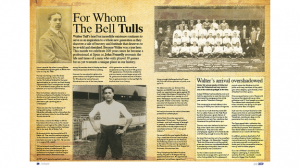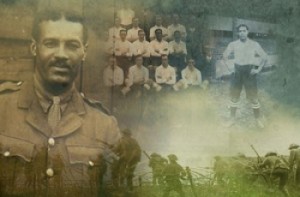Review: ‘The Story of Walter Tull’
by Merilyn Moos
A remarkable and poignant production of ‘The Story of Walter Tull’ was put on by the newly formed Tottenham Theatre (dir. Lynda Brennan), in partnership with the Bruce Grove Youth centre, and supported by the Heritage Lottery Fund.

Page one of an article written by John Fennelly about Walter that appeared in the Tottenham Hotspur monthly magazine Hotspur
The play was chosen for the theatre’s first production partly because of Tull’s links to Tottenham. He was the first black outfield player in the First Division (as it was then) of the football league, signed on by Tottenham Hotspur in 1909. The play highlights the systematic discrimination Tull faced, including racial abuse, making his success a mighty achievement for a black guy at the beginning of the twentieth century.
When war was declared in 1914, Tull volunteered, only again to face institutional racism. In one of many poignant – and ironic – scenes, the actors, many themselves of colour, transform into politicians and army majors, who tell us that military regulations forbid: “any negro or person of colour” becoming an infantry officer. Nevertheless, the play, as in life, shows us that such is Tull’s bravery and leadership, that, despite the rules, Tull becomes the first black British officer.
First black officer
But this is no gung-ho depiction of the bravery of war. In some brilliantly choreographed scenes, made all the more upsetting because I could imagine that at least some of the cast’s families had themselves fled war-torn homelands, the play exposes the death, destruction and futility of the First World War.
The scene with the officers also reveals the deep class divisions within the army and the wider society. The interests of the men are presented as far removed from that of the officers and the ‘gentleman’.
Less developed but running throughout the play, is the theme of the suffragettes campaigning for the vote and the effects of the deadly ‘Cat and Mouse’ Act: letting the women out to recover only to then re-arrest them and start force feeding them all over again. Tull is shown to be close to one of Suffragettes.
 What makes this production so poignant was that the nine amateur actors, who were mostly young B.TEC students in performance arts, were acting, brilliantly, from their own lived experience. All the actors’ education had earlier on been disrupted; a few had had tussles with the law, one had been a young carer, another, a young mother, one had been homeless and sleeping on the street after his refuge shelter closed down. Both because of and despite the knocks they had all previously received, the actors put on an intense and moving performance.
What makes this production so poignant was that the nine amateur actors, who were mostly young B.TEC students in performance arts, were acting, brilliantly, from their own lived experience. All the actors’ education had earlier on been disrupted; a few had had tussles with the law, one had been a young carer, another, a young mother, one had been homeless and sleeping on the street after his refuge shelter closed down. Both because of and despite the knocks they had all previously received, the actors put on an intense and moving performance.
The different scenes of group tensions looked as if they could easily have taken place for real on a street in Tottenham. The dynamic between the two main black actors, Glanville playing Tull, was one of comradeship against the odds, tinged with tautness. At times, the movement on stage had a balletic quality. All the actors played from their hearts. This rainbow of young people face many similar hardships ‘in real life’ to that Tull encountered as a working class and black man a hundred years ago, and their playing was generally inspired.
Vasili, the playwright, spent years researching Walter Tull. Unlike so many ‘heroes’ of the First World War, Tull has remained in obscurity. Vasili wrote the play in part in support of the campaign for Walter Tull to be posthumously awarded the Military Cross. The first performance of the play was at Bolton Octagon, directed David Thacker.
There are other performances likely of this production in North London. Look out for them.


Join the discussion